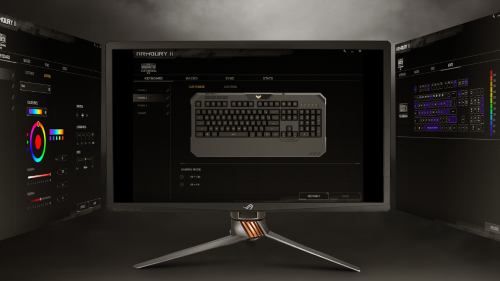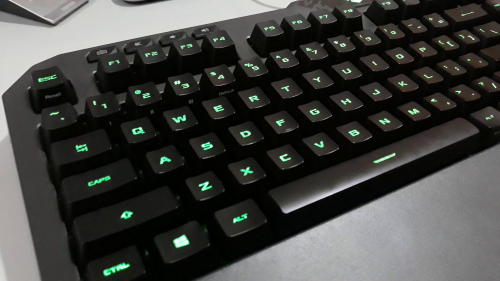
Table of Contents
Introduction
Over the last year or two, the market has slowly flooded with cheap mechanical keyboards from previously unknown brands. This brought the satisfying tactile typing experience, to a much more affordable price and, therefore, to a much broader audience.
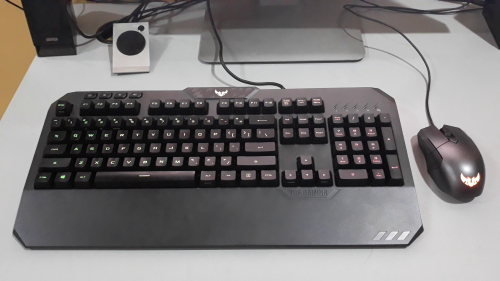
So it seems counter intuitive for ASUS to bring out a gaming keyboard based on rubber dome switches when everyone else has moved on to mechanical ones. But they did, and now we’re here to see if they made the right call.
TUF GAMING K5 KEYBOARD SPECS:
| ASUS TUF Gaming K5 | |
|---|---|
| Switch type | Rubber dome |
| Layout | ANSI, Full-size |
| Anti-ghosting | Yes |
| N-Key Rollover | Yes |
| Lighting | 5-zone RGB |
| Connection | USB Type-A |
| Weight & Size | 1050g 460 x 218 x 40 mm |
| SRP | P4,200 |
DESIGN AND BUILD QUALITY: TUF GAMING K5
The K5 has a matte black finish to make it more upscale. It is susceptible to oil stains from your palms, but I’d take this over glossy plastic any day. Surprisingly, ASUS didn’t go bonkers with the shape and look of the K5. Sure it’s still looks like a gaming keyboard, but only with a few extra edges and subtle branding would suggest that.
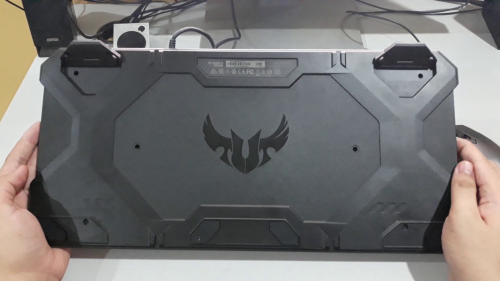
One thing you can’t argue against the K5 is the build quality. Sticking true to its roots, the K5 earns its TUF branding with a fairly stiff chassis and a wrist rest that showed no give even during heavy typing sessions and rage-inducing online gaming marathons. It’s also spill resistant up to 60ml of liquids, good news for those of us who munch down in front of the computer.
The thick plastic feet under the K5 give a satisfying *thunk* when you open and close them. Given the thickness of both the plastic feet and the rubber pads under the K5, it was no surprise that it was able to cling to my slippery desk during use. This was an intentional design by ASUS and they’re proud to point out that the K5’s rubber feet endured 1.5 times more friction test cycles than an unnamed competitor. The USB cable isn’t detachable, but it is quite thick. As a bonus, that thickness should help you distinguish it from other USB cables behind your tower.
TYPING EXPERIENCE – TUF GAMING K5
ASUS is pegging the K5 as a ‘mech-brane’ keyboard, a sort of combination between a membrane keyboard and a mechanical one. Make no mistake however, since the K5 is still pretty much a membrane keyboard with rubber dome switches.
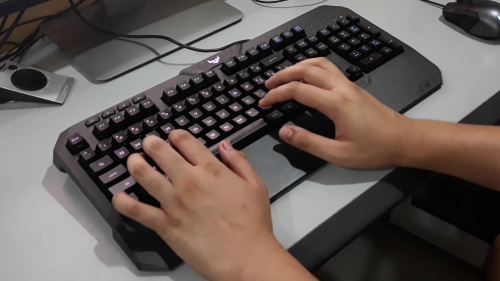
But don’t dismiss it just yet because as far as membrane keyboards go, the K5 is arguably among the best. It’s not as satisfying and tactile as a mechanical blue switch, or as no-nonsense linear as a red switch. However, ASUS’s linear design helps smooth out some of the mushiness of the rubber dome, giving it a much more satisfying feel versus a regular membrane keyboard.
After a month’s use, I found the K5 as a very comfortable keyboard to type on thanks to the softer nature of rubber dome switches. But for gaming, as someone who’s used to having a defined clack of a blue switch registering a keystroke, the mushiness of the rubber domes in the K5 still compromise that precision.
SOFTWARE – TUG GAMING K5
For TUF gaming peripherals, ASUS’s Armoury II software is used for customization. This enables users to record complicated macros, see per-key usage, and setup basic RGB lighting. Sans the software, the K5 also has built-in memory so you can save macros on-the-fly and choose some RGB lighting presets. If none of the presets are to your liking, you can also use the separate AURA Sync software which grants you access to tons of lighting patterns and options.
There’s some funny issue between the Armoury and AURA software where one of them would ask you to stop using the other before letting you set things up. We’re guessing that’s due to both of them having control over lighting so that’s something that ASUS needs to clean up.
LIGHTING – TUF GAMIING K5
Going back to lighting, the K5 supports RGB lighting which is the must have feature for any gaming peripheral these days. It’s not half-baked RGB too, with 5 zones of lighting and good brightness, the K5 can still turn heads even in a well lit room.
Light shines through the keycaps without a problem. ASUS also hasn’t compromised the characters for the sake of aesthetics. Which means, for example, you won’t have a hard time distinguishing the ‘3’ key from the ‘E’ key when you remove the keycaps to clean them.
It’s a shame though that the dedicated media keys on top aren’t backlit as these are very useful keys to use in the dark when you’re watching something.
CONCLUSION
At an SRP of Php 4,200 ASUS is asking a hefty price for, whichever way you slice it, a membrane keyboard. An argument could be made for it if it were targeted more for typing and office use. But being marketed towards the gaming crowd, it’s hard to justify that price unless you’re part of the small niche of people who prefer rubber dome switches to mechanical ones.
It’s a shame when you consider that aside from being a membrane keyboard, the TUF Gaming K5 has a lot going for it. The RGB lighting has vivid colors and good brightness, the solid build quality and spill resistance is reassuring, the styling is not too over-the-top, and has extensive software support, albeit currently not a perfect one.
If the price were lower, like maybe Php 2,000 – 3,000, then the K5 would earn a solid “try it before you judge it” recommendation. But as it stands, it’s bound to be undermined by cheaper mechanical gaming keyboards.
PROS
- Solid build quality
- Superb RGB backlighting
- Spill resistant
- A membrane keyboard that you can actually live with
CONS
- Very pricey for a membrane keyboard
- Quite large
- AURA Sync and Armoury II have some issues

